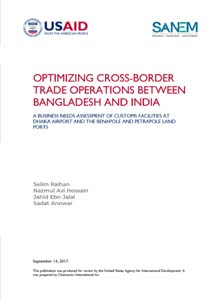Optimizing Cross-Border Trade Operations between Bangladesh and India, AMEG, USAID.
 Citation: Raihan, S., M.N.A. Hossain, M.J.E. Jalal and M.S. Anowar (2017).
Citation: Raihan, S., M.N.A. Hossain, M.J.E. Jalal and M.S. Anowar (2017).
Approximately 80 percent of land trade between India and Bangladesh passes through the Benapole and Petrapole land ports, making this junction one of the largest land ports in Asia by trade volume. Well-functioning business operation facilities and support systems at this land port are essential to deepening connectivity between these two South Asian economic powers. In addition, the Dhaka Airport is critical to Bangladesh’s international trade, with the Dhaka Customs House processing courier-based imports from India and the rest of the world. Private-sector traders complain about delays stemming from burdensome processes, inconvenient operating hours, and insufficient human resources of border agencies. Anecdotal information supplied to the USAID Bangladesh Trade Facilitation Activity (BTFA) suggests that these NTBs could be costing Bangladesh’s garment industry US$1 billion per year in lost orders. While the situation is different at Benapole-Petrapole, private-sector firms complain about similar delays resulting from, for example, operating hours that differ from the officially posted hours. While the general challenges facing these three key Customs Houses — Benapole, Petrapole, and the Dhaka Airport — are well known, the private-sector’s highest priorities are not well understood. Without specific priorities, reform efforts struggle to focus on the changes that would yield the greatest economic impact for the lowest public-sector investment. The USAID Asia & Middle East Economic Growth Best Practices Project (AMEG), in collaboration with BTFA, engaged the South Asian Network on Economic Modeling (SANEM) to assess business needs at the three aforementioned priority ports. Carried out in July 2017, SANEM surveyed 115 stakeholders to critically assess business operations for these three ports. This study sheds light on the primary areas of concern for Indian and Bangladeshi private-sector traders: roads and infrastructure, a lack of space (and need for more warehouse space), security, workforce capacity, synchronized business hours (that match official policy), increased use of technology to expedite clearances, and local rent-seeking behavior, primarily around the Benapole-Petrapole border. Moreover, the study reflects on opportunities to extend services that would enhance bilateral trade, such as health services, hotel and restaurant services, building private warehouses and sheds, provision of safe drinking water and sanitation, and internet access. The research team hopes the findings presented in this study help USAID, the governments of India and Bangladesh, and others design, enact, and implement improvements needed to further integrate these two South Asian leaders.
